
Aerial View of Hangzhou Airport
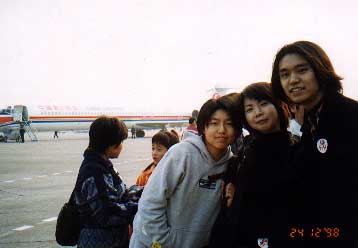
Taking Photos on the Runway
 Aerial View of Hangzhou Airport |
 Taking Photos on the Runway |
Julia could not find her baggage claim sticker as we were going through customs. Fortunately, it was okay because we were the last four people coming out. We followed Eddie to the tour bus, where we were introduced to the local tour guide, who talked and talked as we were driven around the city. Julia and I were trying to translate the Cantonese, respectively to Toshi and Chihiro, but we were not really doing an adequate job.
Hangzhou, located in Zhejiang Province, is one of China's most famous tourist attraction. The city is famous for its West Lake, a large freshwater lake surrounded by hills and gardens, and its banks dotted with pavilions and temples.

Street in Hangzhou
The first tourist place we went today to was the Six Harmonies Pagoda. I had came here before in my previous trip to Hangzhou. This 60 meter high octagonal pagoda is named after the six codes of Buddhism. It was built as a lighthouse, and supposed to have some sort of magical power to halt the tidal bore which thundered up the Qiantang River in mid-September every year. As a legacy of the feudal past, the pagoda was slated for demolition during the Cultural Revolution. However, since an army of demolition experts would be required, that project was called off. Unfortunately, we were not able to go in because it was already too late. That was it for the tour today.

Six Harmonies Pagoda
We then were driven to a restaurant to eat dinner. Our tour group occupied three tables of ten people each. After dinner we went to our hotel, Wanxiang Hotel, a 3 star hotel. We were free and so we roamed around the night. However, we had no direction and returned to the hotel to ask for information. They told us that the West Lake had Christmas lights and that there were department stores there. We went there and bought drinks/snacks at a supermarket. I got a weird fruit drink with fruit piece, some sweet drink with a tad of wine, strawberry milk, orange flavored fig newtons and some cookies. We spent some time watching Chinese McDonald commercials in front of a McDonald's. Julia was hungry so we went to Kentucky Fried Chicken to grab something to eat. Finally we returned to our hotel room where we munched on the snacks and Toshi drank his alcohol.
 Having fun in the Hotel |
 Morning Smog |
The alarm went off at 6:30, but I got up at 6:45. Things start so early in the morning! At 7:15 we had breakfast. Being a buffet, I tried out one of everything. At 8:00, we took off for a boat ride on the West Lake. The West Lake is by far the most famous of the 30 lakes in China called Xi Hu. In fact, it is the West Lake on which all other west lakes are modelled upon. West Lake was originally a lagoon adjoining the Qiantang River. In the 8th century the governor of Hangzhou had it dredged; later a dike was built which cut it off from the river completely. The result was that the lake is about 3 km long and 3 km wide. We went under many bridges, admiring the beautiful scenery. The air was cool and crisp, with a little morning fog. We disembarked on an island and walked around, seeing buildings, peacocks, etc...
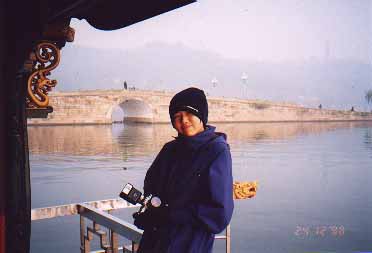
Julia on the Boat
 Birds in a Tree |
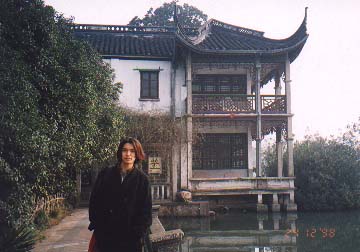 Toshi by a Building |
$3000 HKD is pretty darn cheap for a one week trip in China. Part of the reason why it is so cheap is because as part of a tour group, we visit souvenir shops and such places that make deals with the travel agency. Hangzhou is famous for its Longjia tea so we went to a place which processed this tea. They were selling them for 150, 200, and 230 RMB for varying can size. Julia bought the 200 RMB size as a gift for her aunt. He watched the salesperson grab tea leaves and stuff them into a can. They claimed that they were selling it cheaper than normal prices, as they normally did not fill up the can to the maximum possible amount.
 Tea Leaves on Hot Iron Wok |
 A Water Spewing Tea Fountain |
We went for lunch, but it really was not so good. I almost forgot that today was Christmas day.
 Merry Christmas |
 Julia by Rows of Food |
The Mausoleum of General Yue Fai was next. It was as same as the last time I came here, with paintings, his large statue, statues of horses & bad guys, and his tomb. The story about Yue Fai was that during the 12th century, China was attacked by Jurchen invaders from the north. General Yue Fei was commander of the Song armies. Despite his successes against the invaders, he was recalled to the Song court where he was exectued by a trecherous court official called Qin Gui. 20 years later in 1163, the Song emperor Xiao Zong rehabilitated him and had his corpse reburied at the present site. Yue was eventually defied. His back was famously tatooed with the words, "Loyal to the Last."
 Mausolum of General Yue Fai |
 Riding on Statues |

Statue of General Yue Fai
Next was more advertisement. It was a medicine place which sold Bao Fu Ling, which is supposedly good for aches, burns, etc... The woman pitching this product introduced the medicine to us. Some workers brought out a torch and a chain. The chain was burning hot from the flame. The woman then grabbed the hot chain with her bare hands, showing it to all the audience! It was indeed burned. She rubbed the medicine on her hand and her hand looked better. An old lady in our tour group took out the same medicine out of her purse, saying that she already uses this medicine. The woman examined it and told her that the color should be white instead of yellow and that the medicine has gone bad because it needed to be refridgerated. The woman introduced other medicines but I was already getting tired. When I woke up, they had began purchasing the medicines. The small jar of Bau Fu Ling was 150 RMB and the large jar was 300 RMB. Quite a lot of people were buying medicines because a lot of the people in the tour group were old people. Maybe a total of 3000 RMB were spent.
At Lingyin, or the Temple of Inspired Seclusion, there were monks all over the place, taking care of the grounds, and even selling souvenirs. This temple was built in 326 AD and due to war and calamity, has been destroyed and restored it 16 times. The Cultural Revolution almost put an end to the temple, but Zhou Enlai saved the temple by against those who wanted to destroy the temple by compromising that the temple and rock sculptures would be saved but the monks would be sent to the fields to work. In the main monastery there were the four kings, countless buddhas, a really big Buddha statue, and a beautiful huge Kannon statue. There were small caves with carvings.
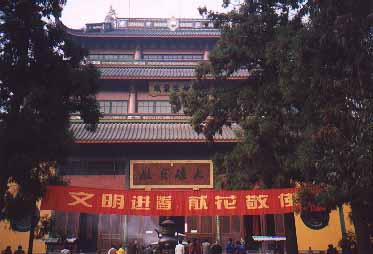
Linyin Temple
 Praying on the Buddha Statue | 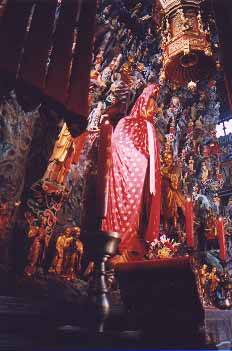 Statue of Kannon | 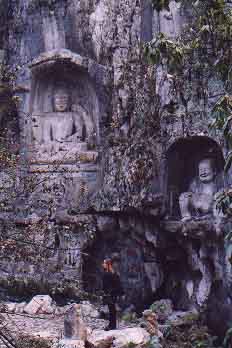 Buddha Carvings on Cave Wall |
At 1800 hours, we all went to dinner. In my opinion, I think dinner is much too early. The restaurant was right next to the monastery. The bus drove us back to the hotel. Julia was too tired and she told us that she would be going to sleep first. The rest of us decided to walk around. We walked for a very long time and eventually found a night market. I have came to this night market before. There were lots of Mao books and watches for sale. Toshi was looking for a knitted cap but could not find a design whichhe liked. I bought a Crayon Shin Chan toy which when doused in hot water, water sqirts out of the thing pretruding under his waist. It was getting late and we returned to the hotel.

Hangzhou Night Market